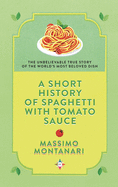
People have been enjoying spaghetti and tomato sauce for thousands of years. In A Short History of Spaghetti with Tomato Sauce, professor of history and nutrition writer Massimo Montanari of Bologna, Italy, serves up a fascinating chronology, deconstructing the roots of this beloved food while also unraveling preconceived notions and misconceptions.
Ingredients for this iconic Italian dish were derived and evolved from many cultures and places: pasta, the dried form, came from Arabs--not, as once believed, from Marco Polo on his return from China. Cheese and tomato--once considered lowly peasant foods--arrived in Italy from Spain via South America. It was Italian culinary ingenuity--along with a penchant for cuisine marked with onions, garlic, basil, chili and olive oil--that ultimately put these components together to form what has become a symbol of Italian identity.
This thorough, well-researched and enlightening narrative highlights the ancient approaches to making and shaping noodles, including the origins of lasagna; ways to cook pasta; how explorers, rulers and even physicians influenced recipes; how utensils, like the fork, played a significant role in pasta consumption; and factors that ultimately led to the development of what is now known as the Mediterranean Diet.
Montanari (Medieval Tastes) sets a beautiful table filled with savory information that will appeal to academics, history buffs, the culinary-minded and those eager to learn how and why twirling a fork into a mountain of spaghetti with tomato sauce has become a delicious source of comforting nourishment, as well as a quintessential and beloved cultural phenomenon. --Kathleen Gerard, blogger at Reading Between the Lines

